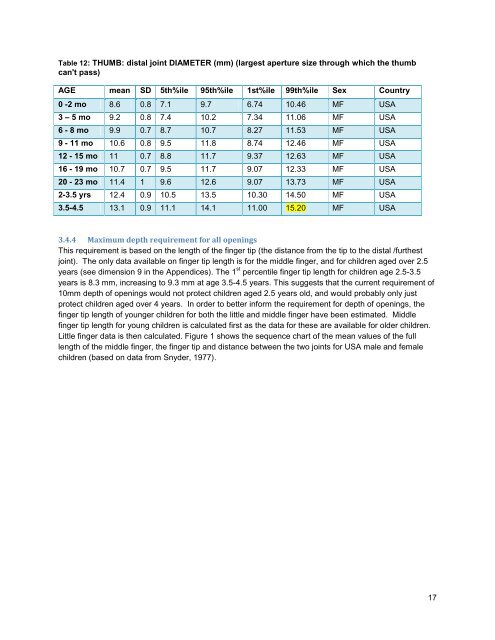Requirements for finger entrapment in European safety ... - ANEC
Requirements for finger entrapment in European safety ... - ANEC
Requirements for finger entrapment in European safety ... - ANEC
Create successful ePaper yourself
Turn your PDF publications into a flip-book with our unique Google optimized e-Paper software.
Table 12: THUMB: distal jo<strong>in</strong>t DIAMETER (mm) (largest aperture size through which the thumb<br />
can't pass)<br />
AGE mean SD 5th%ile 95th%ile 1st%ile 99th%ile Sex Country<br />
0 -2 mo 8.6 0.8 7.1 9.7 6.74 10.46 MF USA<br />
3 – 5 mo 9.2 0.8 7.4 10.2 7.34 11.06 MF USA<br />
6 - 8 mo 9.9 0.7 8.7 10.7 8.27 11.53 MF USA<br />
9 - 11 mo 10.6 0.8 9.5 11.8 8.74 12.46 MF USA<br />
12 - 15 mo 11 0.7 8.8 11.7 9.37 12.63 MF USA<br />
16 - 19 mo 10.7 0.7 9.5 11.7 9.07 12.33 MF USA<br />
20 - 23 mo 11.4 1 9.6 12.6 9.07 13.73 MF USA<br />
2-3.5 yrs 12.4 0.9 10.5 13.5 10.30 14.50 MF USA<br />
3.5-4.5 13.1 0.9 11.1 14.1 11.00 15.20 MF USA<br />
3.4.4 Maximum depth requirement <strong>for</strong> all open<strong>in</strong>gs<br />
This requirement is based on the length of the <strong>f<strong>in</strong>ger</strong> tip (the distance from the tip to the distal /furthest<br />
jo<strong>in</strong>t). The only data available on <strong>f<strong>in</strong>ger</strong> tip length is <strong>for</strong> the middle <strong>f<strong>in</strong>ger</strong>, and <strong>for</strong> children aged over 2.5<br />
years (see dimension 9 <strong>in</strong> the Appendices). The 1 st percentile <strong>f<strong>in</strong>ger</strong> tip length <strong>for</strong> children age 2.5-3.5<br />
years is 8.3 mm, <strong>in</strong>creas<strong>in</strong>g to 9.3 mm at age 3.5-4.5 years. This suggests that the current requirement of<br />
10mm depth of open<strong>in</strong>gs would not protect children aged 2.5 years old, and would probably only just<br />
protect children aged over 4 years. In order to better <strong>in</strong><strong>for</strong>m the requirement <strong>for</strong> depth of open<strong>in</strong>gs, the<br />
<strong>f<strong>in</strong>ger</strong> tip length of younger children <strong>for</strong> both the little and middle <strong>f<strong>in</strong>ger</strong> have been estimated. Middle<br />
<strong>f<strong>in</strong>ger</strong> tip length <strong>for</strong> young children is calculated first as the data <strong>for</strong> these are available <strong>for</strong> older children.<br />
Little <strong>f<strong>in</strong>ger</strong> data is then calculated. Figure 1 shows the sequence chart of the mean values of the full<br />
length of the middle <strong>f<strong>in</strong>ger</strong>, the <strong>f<strong>in</strong>ger</strong> tip and distance between the two jo<strong>in</strong>ts <strong>for</strong> USA male and female<br />
children (based on data from Snyder, 1977).<br />
17
















